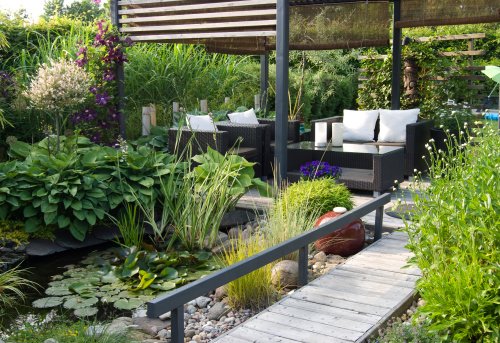Are you longing for that perfect outdoor paradise, which is both beautiful and functional? Landscape design for home is a quintessential way to convert your yard into your paradise. Whatever it is that you aim for – whether creating a peaceful escape, generous occasion space for your friends and family, or even just upping the aesthetic appeal of your house -, deep knowledge of landscape design’s basic principles can take you far. By considering only the key design elements, you can fashion a convivial environment that conveys your lifestyle and conforms to your requirements. These eight elemental principles are the main components that turn a humdrum residential landscape into something extraordinary.
Landscaping is more than just ensuring that you have a green yard. It is an intricate and delicate process of developing an alluring and aesthetic outdoors.
Especially when you have a big property, a detailed and well-planned residential landscape design can help to make your property feel more comfy and private.
Many think that adding some nice furniture and potted plants is all they need to make their home landscape look great. But if you reach out to the experts of your local landscape maintenance services in Clarence and ask about the secrets to creating beautiful landscapes – they will explain the essential fundamentals they use to transform barren land into a beautiful retreat.
So today, let’s learn about these 8 key principles of home landscape design.
8 Basic Principles of Residential Landscape Design
Unity
The most fundamental principle in landscape design is unity – the repetition and consistency of designs. Repetition creates uniformity in your design by repeating similar elements, including plants and decor, across the landscape.
Consistency creates unity by combining different elements of the landscape together into a common unit or theme.
Balance
Balance in residential landscape design simply means a sense of equality. There are two types of balance in the design: symmetrical balance and asymmetric balance. When two sides are kept equal, it’s a symmetrical balance.
However, in an asymmetrical balance, the landscape’s composition is balanced with different elements and objects with roughly the same imaginary weight.
Harmony and Contrast
Contrast and harmony are achieved by combining artistic elements or using complementary colors. While balance helps make the landscape look more unified and seamless, contrast is used to highlight the particular element of your landscape.
Contrasting elements attract the viewer’s attention when placed next to each other.
Color
Color gives your landscape design a real-life dimension. Warm colors such as red and orange appear like they are moving toward you. While cool colors like blue and green seem to be going away. Blue and green are used to create perspective.
Transition
Transition in landscaping is indicated by gradual plant size or color intensity changes. Simply put, it’s a gradual change. It can also be applied to the texture, shape of leaves, and size of various elements.
Line
The mother of all basics – lines – are a powerful design element that defines rooms and connects people with the scene. Lines are used almost everywhere, including creating beds, sidewalks, textures, and perspectives. Lines are also used to create the illusion of depth and distance.
Proportion
Proportion refers to the size of one element relative to another. Of all the principles of residential landscape design, this is the most obvious, but it still requires a bit of planning and thinking. It is necessary to ensure that all elements of landscape design are in the right proportions.
Repetition
Repetition has a direct relation to unity. It’s nice to have more elements and shapes in the garden, but repeating the same elements gives your design different expressions. Too many irrelevant things can make your proposal unplanned and confusing. Also, don’t use one feature too much because overusing one element can make your design boring, uninteresting, and monotonous.
Let’s Design!
Now you know how the experts of Soil and Seed Landscaping NY create charming and gorgeous outdoors for the homeowners of Clarence – and how much understanding, work and dedication goes into it.
So why are you waiting? Contact us for your next residential landscape design project!




